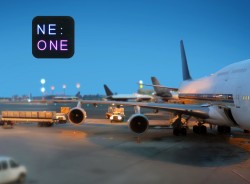ONE Record: New era of air freight thanks to automated data chains
Data silos are a thing of the past. What modern air freight needs today are end-to-end automated digital chains for accelerated data transfer. Together with Fraunhofer, IATA and Lufthansa Cargo, ISO Software Systeme GmbH has revised the specification for ONE Record, paving the way for the Internet of Logistics.

ONE Record takes digitalization in air freight to a new level. The aim is to integrate individual entities such as packages or bookings into an overall digital concept in such a way that they can be addressed and linked. This makes it easier to identify and track goods shipments in air freight via various stations worldwide.
The core idea of ONE Record is to create an end-to-end automated digital chain. This speeds up data transfer, avoids duplicates and ensures identical data packages. Everyone who works with such a data package receives a link to the data record, e.g. a package or a booking. Events such as loading, unloading, damage, etc. can be stored here. This is also referred to as the Internet of Logistics (IoL), which incorporates supply chains, inventories, and their management in order to optimize the global movement of goods. The initiator is the Federal Ministry for Digital and Transport Affairs (BMDV). The Federal Office has also given the go-ahead for the Digital Test Field Air Freight to standardize data exchange in air freight.
Specification for ONE Record refined
The Fraunhofer Institute for Material Flow and Logistics has commissioned ISO Software Systeme GmbH to implement the specifications for ONE Record. In order to solve the task, the specifications originally provided by IATA were formulated further. Our development team first had to adapt the specifications to the best practices of the RDF framework in a few places. To do this, the developers refined the publish-subscribe model and made changes to the logistical objects to support an asynchronous data model.
Together with Fraunhofer, Lufthansa Industry Solutions, Lufthansa Cargo and IATA, the specification was refined to such an extent that the ISO team was able to begin implementation. The ISO-Gruppe, and in particular the responsible team leader Dominik Kunz, is listed as a contributor by IATA for its involvement in the revision of the specification.
RDF instead of JSON
Another requirement for the ISO team was that the server should offer additional functions over and above the specification. For example, a document repository with additional access control was required. However, the specification only stipulated that such a repository must be available, but not how and where. It also remained unclear which technologies should be used and how.
The IATA had already decided in advance to rely on the RDF (Resource Descriptor Framework) data model for ONE Record. It was therefore only logical for the ISO team to also use an RDF database in the backend. In contrast to the usual JSON document databases, an RDF database offers the advantage that the semantic data format of RDF ("SPARQL", generation of new knowledge through inference) can be fully utilized. However, RDF is a rather unusual format that was developed in the late 1990s as a general language for formulating metadata in web browsers. RDF lent itself to use in ONE Record because the framework has an open approach and is easy to extend. In addition, the representation of the data is standardized. IATA therefore opted for the RDF format. The ISO Software Systeme GmbH team was then responsible for the End2End implementation and ensured that the data was persisted in this format.
More benefits through linked data
In ONE Record, data is stored according to the linked data principle. In other words, as structured data that is linked to other data and can be made more usable through semantic queries. In contrast to Linked Open Data (LOD), however, the data in ONE Record is private and therefore protected.
The project is open source, which was also the explicit wish of Fraunhofer. Data is synchronized via the ONE Record interface. To be able to use this as a company, you must authenticate yourself with the IATA. This requires an identity provider, which IATA offers. Alternatively, you can also host this yourself. If you adhere to the specification, compatibility, and communication with other ONE Record servers is guaranteed.
NE:ONE reference implementation
The final work packages have long since been completed and the outcome has given a new name: “NE:ONE”. It is now the reference implementation of the IATA Cargo Standard. What's next? A pilot project, for example. Initial talks with well-known logistics companies and logistics software providers have already taken place.
Does the topic sound exciting to you? Contact us and find out more.
